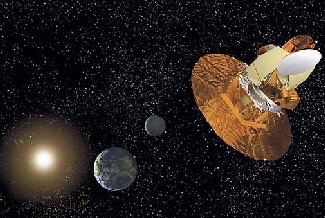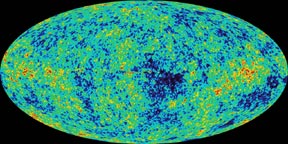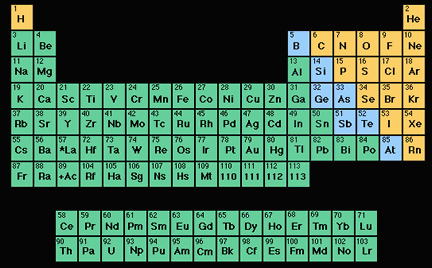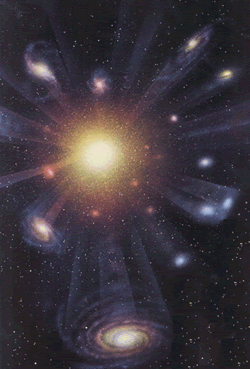This is a picture of the Big Bang. The Big Bang was an explosion that began the Universe.
Click on image for full size
Windows original.
Related links:
Back to Cosmology
The History of the Universe in 60 Seconds or Less - Dr. Eric Schulman - streaming RealVideo (1 min. 16 sec.) from NSF
Einstein's Messengers - LIGO Documentary - streaming RealVideo (20 min. 12 sec.) from NSF
A Matter of Scale - interactive showing the sizes of things, from very tiny to huge - from NSF
The History of the Universe
Astronomers have tried to explain what we see in the universe around
us. The simplest explanation for everything we know about the
universe is called the
Big Bang theory. This theory says that
in the beginning, everything in the universe was all in one
place. Something unknown caused the universe to begin growing. The universe
began growing very quickly, and the universe is still
growing even today.
At the beginning, when all the matter in the universe was contained in
a very tiny volume, it was very hot. As the universe started to grow,
it cooled off very quickly. When the universe was about 500,000 years
old, it had cooled enough that it was possible for the atoms that make
up stars and galaxies to begin to form. Energy released when the
universe was small and dense, the cosmic microwave background
radiation, still fills the universe today. By studying this
energy, astronomers can learn what the universe was like when stars
and galaxies were first able to form.
So how old is the universe? Astronomers argue about the exact age of
the universe for many reasons. But they do agree that it is somewhere
between 10 and 20 billion years old.
You might also be interested in:

Some really cool pictures were taken by NASA's Hubble Space Telescope! The gravity of galaxies and black holes is able to bend the light coming from behind it. This makes a lens of light around the object.
...more
NASA launched a new satellite called the Far Ultraviolet Spectroscopic Explorer (FUSE). It will help scientists study the Big Bang by looking at light coming from objects far away. This will allow scientists
...more
After the Big Bang, the universe was really hot! The leftover heat from that time is still around today. It is called Cosmic Microwave Background Radiation (CMB). CMB radiation is everywhere! It is in
...more
Good news! The Microwave Anisotropy Probe (MAP) was launched successfully last Saturday! Liftoff happened on time on June 30, 2001. The MAP teams says they couldn't have asked for a better start to the
...more
NASA scientists have taken a "snapshot" picture of the oldest light in the universe. The picture shows what is left of light given off during the big bang. The light is over 13 billion years
...more
An element (also called a "chemical element") is a substance made up entirely of atoms having the same atomic number; that is, all of the atoms have the same number of protons. Hydrogen, helium, oxygen,
...more
Isotopes are different "versions" of an element. All atoms of an element have the same number of protons. All hydrogen atoms have one proton, all carbon atoms have 6 protons, and all uranium atoms have
...more














